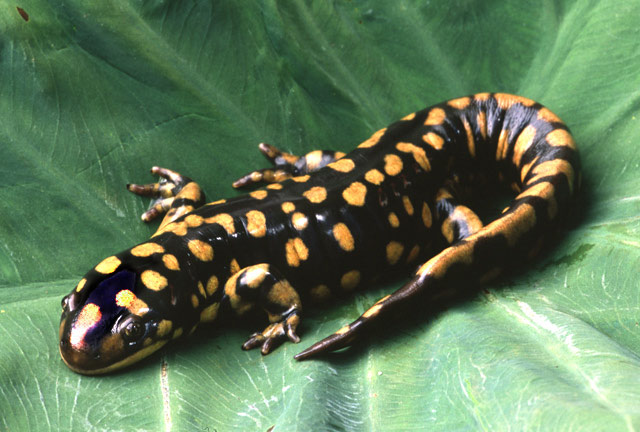- In real life, salamanders like to live in watery or moist environments.

This is a Tiger Salamander from Illinois
(Photo from MichaelCravens.com)
- Salamanders are also known as newts.
- They don't have scales or hair or feathers, just a smooth skin that is often moist or even slimy to the touch, like frogs.
- They are very closely related to frogs, in fact (they are also related to the Mexican axolotl).
- Salamanders begin life in the water, much like frog tadpoles. Once they transform from larvae into their adult bodies, most will leave the water and live on the land.
- Wherever they live, all salamanders need to be near water or somehow be able to keep their skin moist. If their skin dries out, they will dehydrate and die.
- Another caution: it's really not good for salamanders if you touch them. They have their whole super-slick skin thing working for them, and the oils and dirt and stuff on your skin will mess that up. So don't pick them up or touch them.
- Salamanders are nocturnal. They hunt for their food at night, eating insects, earthworms, millipedes, aphids, and moths.
- Most salamanders live in the Northern Hemisphere, and primarily in North America. Some live in Central or South America. They're also spread across Europe (they seem to be really popular in the Netherlands), all the way across the expanse of Russia over to Japan.

This picture of a salamander in fire was drawn in 1617.
(Image from Strange Science)
- The word "salamander" comes from a Greek word that means "fire-lizard."
- According to Greek mythology, salamanders were believed to be able to quench fire. Such notables as Aristotle and Pliny said they had observed this very characteristic.
- Here are some possible explanations for why Aristotle and others through the centuries believed this about salamanders:
- The necessary moistness of the salamander's skin may make the animal more resistant to fire to begin with. They also secrete an extra, milky slime when they encounter fire, so this does give them a bit more imperviousness.
- Some species of salamanders like to live in rotting logs. When people picked up the rotting logs and threw them on the fire, the salamanders scurried out to safety. Thus people thought the salamander could survive being thrown into a fire.
- Another thought is that since most salamanders like to live in the water, they are more likely to survive a wildfire than other types of animals. Here comes a fire, jump in the water, wait for the fire to go out, come back out of the water, and lo, it looks like the salamander lived through a fire.
- In fact, many salamanders thrive in post-wildfire environments, where loose debris that is also moistened by a hard rain covers the forest floor, and insects get to stirring over the remnants.
- Of course the myth-makers weren't content to let the salamander stop at being able to combat fire. Over time, the salamander became larger, and it lived in fires, and it liked fires so much that it became an animalistic symbol of fire. Salamanders became something like dragons, except without the malevolence.

This salamander from a game of the same name looks more like a snake or a dragon, but it's a salamander and apparently there was lots of fire involved.
(Image from Insomnia)
Other notable appearances of salamanders:
- In Marco Polo's records of his visit to China, he reported that his Chinese hosts gave him something called salamander cloth. It could not be burnt even if it was thrown into a fire. He was told it was made from the hair of salamanders, but in truth, it was asbestos.
- In Ray Bradbury's Fahrenheit 451, the firemen's truck is called the salamander.

Guy Montag at work on the salamander, in the movie version of Fahrenheit 451.
(Photo from Squidoo)
Sources
James L. Byford, "Salamanders Handbook," School of Agriculture and Home Economics, University of Tennessee
Melissa Kaplan's Herp Care Collection, Salamanders and Newts, August 17, 2002
Living World.org, Amphibia: Caudata
Environmental Literacy Council, Salamanders
Global Oneness Commitment, Salamander - Mythology
Answers.com, Amphibians and humans
Sylvia Volk's Asia Page, University of Calgary, Ancient Uses of Asbestos
Bookwolf, Fahrenheit 451, Questions for study with answers
Fascinating little guy. Thanks for sharing.
ReplyDelete\I would like to know if you could kill a salamander if you feed it to much? How much should feed him?
ReplyDeleteYes, it is possible to overfeed a pet salamander. Check out this site for some general information about care and feeding: http://www.caudata.org/cc/faq/FAQcar.shtml
ReplyDeleteHey, not really sure who makes this but I am currently googling salamanders and came across this. Very interesting to read, good job! When I was younger I found a few salamanders and we had them as pets and fed them worms, money was very tight back then and my mother (not the best, hence no communication anymore) let them die before we moved yet again...well, one died, we let the other two go outside before we moved. uhhh long story short, I recently moved out of my gpa's to attend a University I will not name. I have been planning on this for a while with a mini ecosystem and whatnot for a salamander similar to the picture you have...because that was the kind we found. Spotty, Speedy, and Goldy were there names haha Thanks for the post!
ReplyDeleteHi Justin, thanks for the comments! I'm glad you're going to get your own salamander ecosystem. Spotty, Speedy, and Goldy would be pleased. :) Happy salamandering!
ReplyDelete